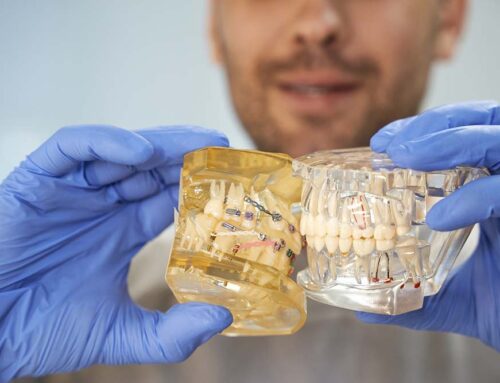Root canal treatment, also known as endodontic therapy, is a dental procedure designed to treat infection at the center of a tooth (the root canal system). The aim is to remove all infection from the root canal and protect the tooth from future microbial invasion. Here is a step-by-step breakdown of the process:
Step 1: Diagnosis and Initial Consultation
The first step in root canal treatment is diagnosing the issue. Patients typically seek dental care due to pain, swelling, or sensitivity to hot and cold. During the initial consultation, the dentist will take a detailed medical history and perform a thorough examination of the patient’s mouth. Diagnostic tools such as X-rays are used to confirm the presence of infection or damage to the tooth’s pulp.
Step 2: Pre-Treatment Discussion
After diagnosing the need for a root canal, the dentist will discuss the procedure with the patient. This includes explaining the steps involved, potential risks and complications, benefits, and aftercare instructions. Informed consent is obtained before proceeding.
Step 3: Anesthesia
To ensure patient comfort, the dentist administers a local anesthetic to numb the affected tooth and surrounding tissues. This helps to eliminate pain during the procedure. In some cases, if the tooth is severely infected, the anesthetic may take a bit longer to work or additional doses may be required.
Step 4: Isolation of the Tooth
Once the area is numbed, the dentist isolates the affected tooth using a dental dam. This small sheet of rubber prevents saliva from entering the treatment area, keeping it dry and free from contaminants.
Step 5: Access Opening
The dentist creates an access opening in the crown of the tooth using a dental drill. This allows access to the pulp chamber and root canals. The opening is typically made on the biting surface of a back tooth or the lingual surface of a front tooth.
Step 6: Removal of Infected Pulp
The next step involves removing the infected or inflamed pulp tissue from the pulp chamber and root canals. This is done using special dental instruments called files. The dentist carefully cleans and shapes the canals, removing all traces of infection and debris. The canals are then flushed with an antimicrobial solution to disinfect the area and prevent further infection.
Step 7: Shaping the Canals
Shaping the canals is a critical step that involves widening and tapering the root canals to facilitate the filling process. This is achieved using a series of progressively larger files. Proper shaping ensures that the filling material can be placed effectively, sealing the canals completely.
Step 8: Cleaning the Canals
After shaping, the canals are thoroughly cleaned to remove any remaining debris and bacteria. This involves using an irrigation solution, often sodium hypochlorite, which is delivered through a syringe. The solution helps to disinfect the canals and flush out any remaining particles.
Step 9: Drying the Canals
Once the canals are clean, they must be completely dried before filling. This is done using paper points, which are absorbent paper cones that fit into the canals. The dentist inserts these points into the canals to soak up any residual moisture.
Step 10: Filling the Canals
With the canals clean and dry, the dentist fills them with a biocompatible material called gutta-percha. This rubber-like material is used in combination with an adhesive cement to ensure a tight seal within the root canals. The dentist places the gutta-percha in the canals and compresses it to fill the space completely.
Step 11: Sealing the Access Opening
After the root canals are filled, the dentist seals the access opening in the tooth with a temporary or permanent filling material. This helps to protect the tooth from contaminants and allows it to heal. If a temporary filling is used, a permanent restoration will be placed at a later appointment.
Step 12: Post-Treatment Restoration
In most cases, a tooth that has undergone root canal treatment will require additional restoration to restore its function and appearance. This often involves placing a crown over the treated tooth. Crowns provide strength and stability, protecting the tooth from fracture and ensuring it can withstand normal biting forces.
Step 13: Follow-Up Appointments
After the procedure, the dentist schedules follow-up appointments to monitor the healing process and ensure the tooth is recovering well. X-rays may be taken to confirm that the infection has been resolved and that the canals are properly filled. The dentist will also check the integrity of the restoration and make any necessary adjustments.
Step 14: Home Care and Maintenance
Proper home care is essential to maintain the health of a tooth that has undergone root canal treatment. Patients are advised to brush and floss regularly, avoid chewing on hard objects, and attend regular dental check-ups. The dentist may also recommend using an antimicrobial mouthwash to reduce the risk of further infection.
Step 15: Monitoring for Complications
While root canal treatment is highly successful, complications can occasionally arise. These may include reinfection of the root canals, fractures in the treated tooth, or failure of the restoration. Patients should promptly report any signs of pain, swelling, or changes in the treated tooth to their dentist for evaluation.
Step 16: Retreatment (if necessary)
In some cases, retreatment may be necessary if the initial root canal treatment fails. This involves reopening the tooth, removing the previous filling material, and addressing any remaining infection or issues. Retreatment may require more advanced techniques and specialized equipment.
Conclusion
Root canal treatment is a meticulous and precise procedure aimed at saving a tooth that would otherwise need to be extracted. By following these steps, dental professionals can effectively eliminate infection, preserve the tooth, and maintain the patient’s oral health. Proper diagnosis, technique, and aftercare are essential to ensuring a successful outcome and preventing complications.
The key to successful root canal treatment lies in thorough cleaning and shaping of the root canals, complete sealing of the canals with biocompatible materials, and effective restoration of the tooth. With advancements in dental technology and techniques, root canal treatment has become a highly predictable and routine procedure, offering patients a chance to retain their natural teeth and enjoy a healthy, functional smile.






